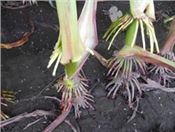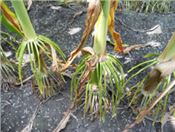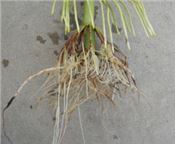Wet Soils And Corn
DR. EMERSON NAFZIGER
URBANA, ILL.
The 2021 cropping season in Illinois (and the Corn Belt) continues to be a story of haves, have-nots, and have-way-too-much with regard to rainfall. In the first three weeks of June, nearly all of Illinois had below-normal rainfall, and concerns about dryness increased. That ended abruptly: in the three weeks from June 25 through July 14, rainfall totals ranged from below normal in the northwestern counties to 25 to 75 percent above normal in southern Illinois to 100 to more than 200 percent above normal in central Illinois, with some parts of western Illinois (and scattered areas elsewhere) getting more than 10 inches of rain during that period.
Crop condition ratings responded accordingly, with good + excellent ratings of 80 percent for corn and 77 percent for soybean on May 30 dropping, by July 11, to only 60 percent for corn and 56 percent for soybean. Such drops from high to mediocre during the first half of the season are unusual: this happened during the drought of 2012, but it’s more common for ratings to start low and move up than the other way around, and drops in ratings tend to come from dry weather during mid-season. The 2011 season showed a trend like 2021, and for a similar reason – a major rainfall event in the last week of June while the crop was growing rapidly.
The real concern from ponding and saturated soils during mid- to late vegetative development is the health of roots. Root system development was stimulated by dry soil conditions, demonstrated by the fact that corn showed good growth and nutrient uptake despite dry conditions in June. With good conditions for mineralization, good soil aeration, and minimal downward movement of soil N resulting from moderate or low rainfall, plants took up N well: canopy color in most fields was good to excellent by mid-June. In N rate studies, corn in plots without any N fertilizer developed good leaf color as well, and N deficiency appeared in these plots later than it normally does.
The first few inches of rain that fell the last week of June helped replenish soil water supplies, and were welcomed. But when inches kept accumulating, soils became saturated and water began to accumulate in low part of fields. Roots of fast-growing crops quickly use up the oxygen in saturated soils, and oxygen movement into saturated soil is very slow. Carbon dioxide given off by the roots and by soil microbes also accumulates, and is toxic to roots. Roots in saturated soils soon stop taking up nutrients, and plants begin to turn yellow as N deficiency intensifies. Larger plants have more N already in the plants, and this slows the development of deficiency.
In one of our studies located in Drummer silty clay loam soil at South Farms, corn planted on April 26 was at stage V13 (about head-high) with outstanding canopy color, when the rain began on June 25.
Between June 25 and July 1, a little more than 4 inches of rain fell, which was enough to cause water to stand for a few days in the lower- lying part of the field where the trial was located. [The trial was located there because growth was better in early June due to the better water supply.] Soils were still very wet on July 7, when the photo shown below (Figure 1) was taken. Note that brace roots that had developed on the lower 2 aerial nodes appeared to be dead; mud on them shows that they had been submerged. A new ring of brace roots can be seen elongating at the node above. Plants were tasseling by then, and leaf color remained fairly good.
While having brace roots emerge at higher nodes to replace damaged ones seems encouraging, the new brace roots shown in Figure 1 had not reached the soil, so were not yet able to help with nutrient or water uptake. Producing new brace roots takes energy, in the form of sugars in the lower stalk. That sugars were available for brace root initiation and growth may indicate that the main root system was not using sugars as fast as normal, leaving more available. Brace root growth pattern is a hybrid trait to some extent, but excessive brace root growth is often an indication that something has gone wrong, leaving too much sugar in the lower stalk. When this happens close to pollination, it’s possible that more sugar in the plant could be helpful to kernel set. But roots produce some plant hormones and their health affects the plant in other ways, so while extra brace roots show that the plant is still photosynthesizing to produce sugars, we can’t take it as a positive.
We were fortunate to miss most of the inches of rain that fell in other parts of Illinois during the first two weeks in July. Although the soil was still wet, root systems in the low part of the field had revived to some extent by July 14, with at least some of the initial brace roots (which a week earlier appeared to be dead) having branched out and to send smaller roots into the soil (Figure 2). The new brace roots had continued to elongate, but most of them had not yet reached the soil surface. Pollination was nearly complete, as indicated by the dry anthers on the ground. Lower leaves were no longer green, having lost most of their N and begun to die off.
A plant similar to those shown in Figure 2 was pulled and its roots washed off to show the distribution and state of the root system (Figure 3). Although original (thick) roots growing down and away from the base of the stem appear to be dead past a few inches from the stalk, roots originating from the brace roots have formed a new root system, including some roots that had reached 6 to 8 inches deep in the soil. A few of the new ring of brace roots had also entered the soil, and others were poised to do that soon.
It is certainly beneficial that the plants had survived and that they appeared, at least above-ground, to be relatively healthy. Leaves in the center of the stalk, around the ear, still had good color. It appears that kernel set should be close to normal in these plants. The uppermost few leaves aren’t as dark green, though – Figure 4 shows the contrast between middle and upper leaves. But whether or not the problems caused by wet soils have been alleviated by root regrowth will depend heavily on what happens during the next six weeks. The forecast for the third week of July is for limited rainfall, which will help the new root systems to grow more and perhaps to take up the N needed to restore or maintain green leaf color. If dryness extends over a longer period, though, the root system may not be able to provide the water needed – up to a quarter inch per day – to maintain the high rates of photosynthesis needed over the next six weeks to keep and fill kernels. And, if a lot of rain falls again, the new roots may suffer anew.
Maintaining high photosynthetic rates will require plant nutrient uptake: roughly one-fourth of the N, one-third of the P, and one-sixth of the K remain to be taken up between the end of pollination and maturity. Water coming into the plant will bring some N with it, although with N likely depleted by denitrification in saturated soils, this may need to come mostly from mineralization, which may not start up as quickly as needed. Non-mobile nutrients like P and K could be more difficult for a diminished root system to reach. Whatever the case, keeping photosynthetic rates high with a diminished root system will be a challenge.
This example used here, of plants with root damage but potential for good yields, lies somewhere in the middle of a damage/potential scale, between plants that stood in water for a week or more or are still standing in water, most of which are dead or dying, and plants that were in wet soils but that did not stand in water. With warm temperatures and rapid plant growth during late vegetative stages, corn roots typically stay alive in standing water for no more than a few days. Where water never stood, plants may be in good shape still, although soil saturation in areas with high rainfall over many days may have had their root systems compromised to some extent.
The real measure of how things are underground will be how well canopy color holds up through August. We are optimistic, but getting to good yields will take a lot of cooperation from the weather. ∆
DR. EMERSON NAFZIGER: Research Education Center Coordinator, Professor, University of Illinois

Figure 1. Brace roots on plants in wet soils on July 7, several days after flooding.

Figure 2. Brace roots on plants in wet soils on July 14.

Figure 3. Root system on a plant similar to those shown in Figure 2.

Figure 4. Upper canopy on corn plants growing in wet soils.